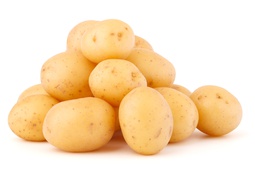
WAXY POTATOES
Waxy potatoes contain more water and less starch than floury potatoes. This means that they still hold together when heated, despite the fact that heating means that the starch hardens and the dry matter – the parts of the potato that aren’t water – expands.
Choose waxy potatoes in al contexts where you don’t want your potatoes to fall apart; boiled, deep fried, fried or baked. Some waxy varieties are Charlotte, Maris Peer Jersey Royals, Bintje, Asterix, Viktoria, Maria and Annabelle.
Most people avoid waxy potatoes when making mash or purée. But there are chefs who say that waxy potatoes give the best, and the smoothest, mash. As with so many other things in life – it all comes down to a matter of taste. Try and see.
The potatoes we buy these days are almost always washed. You don’t need to peel them. It’s unnecessary because they lose flavor and nutrients. Go for organic potatoes, rinse them and wipe off any dirt.
Keep in mind
To make sure the potatoes don’t start to sprout – and so that the poisonous substance solanine doesn’t form – potatoes mustn’t be exposed to light.
The taste, consistency and nutrients in the potato keep best at temperatures between 4 and 7°C. Too low temperatures make the potatoes sweet. A cellar or a pantry is the perfect place to store them.
Potatoes you have rinsed should be cooked fairly soon afterwards. Rinsing may have set in motion processes that make the potato unsuitable for eating.
How to cook waxy potatoes
Waxy potatoes can be boiled, fried, deep fried, oven baked and spread their mild, slightly nutty flavor in gratins, soups and casseroles. Where you want your potato to have a bit of bite left and to keep together, go for waxy potatoes.
Boiled potatoes are part of our cultural heritage and are completely indispensable with meatballs, with a smooth creamy sauce or carefully cooked cod with a sting of horseradish. Learn the art of boiling potatoes:
- Use a big enough pan, the potatoes should cover the bottom. Pour in water so that it just covers the potatoes.
- Add salt (1 tsp salt per liter water) and bring to the boil at the highest heat. Use a lid.
- Turn down the heat once the water has come to the boil.
- It should boil but not madly. Estimate about 20 minutes.
- The potatoes are ready when you prod them with a skewer, a knife or a fork and don’t feel any resistance.
Remember to choose potatoes that are the same size – or cut bigger potatoes in half – when boiling them, so that they are all done at the same time.
Oven-baked potato wedges have an attractive surface and are firm in the mouth. If the potato peel isn’t very thick, keep it on. Slice the potatoes into chunks, drizzle with a little olive oil and bake in the oven at approximately 200°C for about 30 minutes. A sprig of thyme or rosemary can be added.
Make your own chips: It’s not difficult, they’ll come out beautifully crisp, and everything you need to know is here.
Serve deep fried potato skins: Make sure the potatoes are properly washed. Peel away a bit more than the peel with a sharp knife. Then deep fry the shells and serve them with drinks, e.g. with a spoonful of sour cream and a bit of whitefish roe.
Bake with butter:
- Peel potatoes and cut them into slices but not all the way through. One tip is to put the potatoes in a wooden ladle, cutting into them and stopping where the ladle meets the blade.
- Bake in the oven at 225°C for approximately 20 minutes.
- Brush the potatoes with butter, sprinkle with breadcrumbs and return to the oven for another 20 minutes.
Fried potatoes: Cut them into dice and fry with other root vegetables, for example. Or make a raw grated salad: Grate the potatoes. Add salt and pepper, mix and spread out the potato into a thin layer in a hot frying pan with plenty of butter. Enjoy with sour cream, salted whitefish roe and finely chopped red onion.
Mix to make potato salad: Boil the potatoes (without overcooking, keep an extra eye on them). Choose between creamy varieties – ideally with Dijon mustard – or throw a vinaigrette over the hot potatoes and slice in some spring onions or leeks. Fresh herbs such as flat leaf parsley, oregano, thyme and sage are good additions.
Try papas arrugadas: Small potatoes are boiled in a small amount of water with a large amount of salt until the water has evaporated. What you end up with are wrinkled potatoes with loads of flavor. Dip them in a hot red or green sauce: mojo rojo or mojo verde. The recipe comes from the Canary Islands and the salty water was originally sea water.
Serve rösti: Swiss potato cakes made from coarsely grated potatoes baked in the oven with leek and egg will keep guests well fed all night.
Potatoes in soups and stews: Dice the potatoes and add them to a vegetable soup or goulash. A waxy variety will keep its shape even if boiled for a while.
The classic
Semi-sliced and oven-baked with butter with a great piece of meat or fish.







